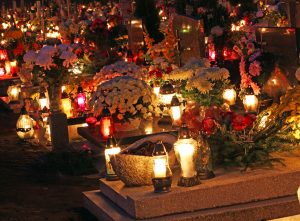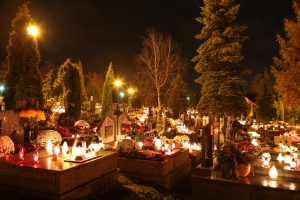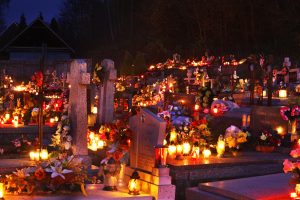Feast of the Dead
On 1 November, we celebrate All Saints’ Day in Poland. It is a Catholic holiday, but also a day off work, a time of reflection and reverie. On this day, Poles go to cemeteries with their whole families to light candles, place bouquets of flowers and pray for deceased family and friends. It is customary to light candles also on the graves of the forgotten, those no longer visited by loved ones.
Apart from Catholics, this holiday is celebrated by a number of other faiths, and it is also a custom practised by non-believers to show remembrance and respect for the dead.
On this day, Polish cemeteries look extraordinarily beautiful and colourful, especially at dusk, when thousands of lights illuminate the evening, and flowers and wreaths shimmer in their light.
The burning of bonfires used to be a symbol of this festival. In the past, especially in the eastern areas, large bonfires were lit near cemeteries and at crossroads, so that the souls could warm themselves by them before the long journey back to the afterlife. In addition, fire was believed to protect people from evil spirits and ghosts, which is why All Souls’ Day fires were always lit on the graves of people who had died a violent death, especially suicides. Today, burning candles are simply a symbol of remembrance of the dead.
The date of the feast was set by the Church in the ninth century. Although visiting graves was and is a custom known to almost all peoples and handed down from generation to generation, Christians took up this tradition and gave it a religious dimension. In 835, Pope John XI established All Saints’ Day in honour of the dead, already saved.
All Souls’ Day, on the other hand, is celebrated on 2 November. As the name suggests, this is a day of prayer for the souls of the dead. Catholics once again go to cemeteries, light candles and pray for those who have already departed from this world, but are in Purgatory and need our prayers so that they can receive salvation.
It used to be believed in Poland that on All Souls’ Day the souls of the dead visited their homes, so houses were cleaned and prepared to welcome these special guests. A bench was placed in the middle, and on it a bowl with water, a towel and a comb. This was because it was believed that the souls would want to wash and comb their hair. In order for the souls to enter the house, the doors and windows were kept open all night.
Both past and present celebrations of the Feast of the Dead share the same idea: the enduring memory of those who have walked our earth before us.
Photos: Adobe Stock, Depositphotos, Canva









